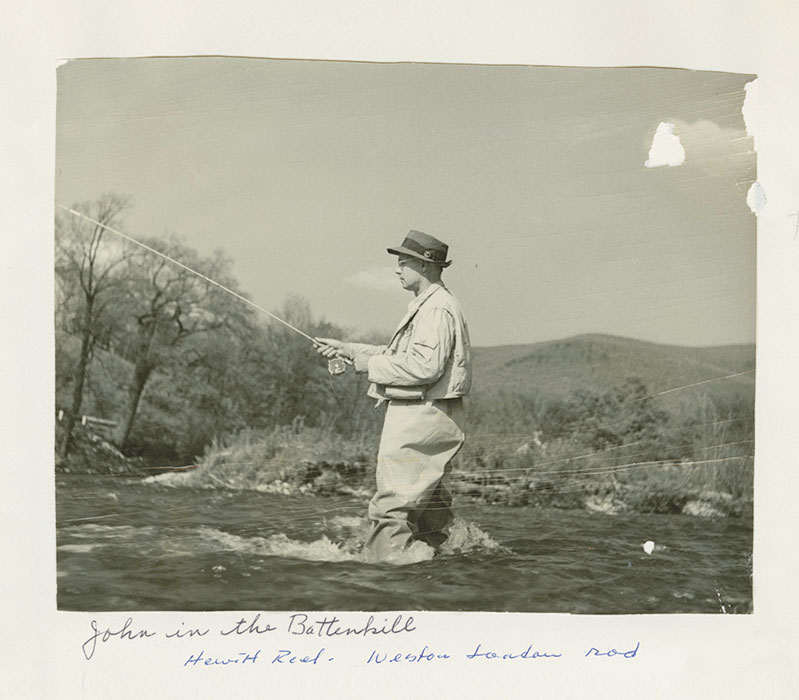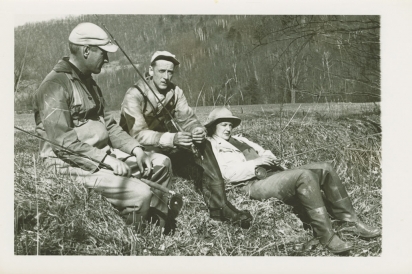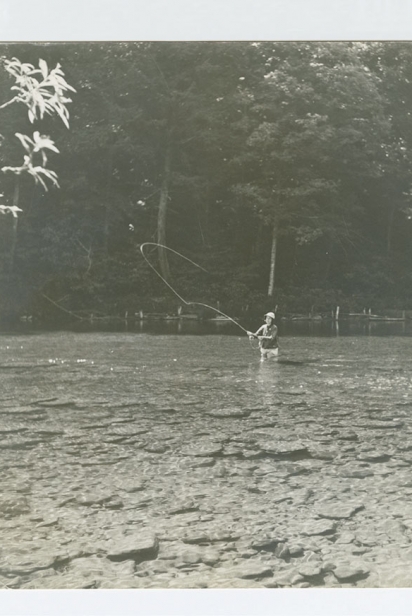Cast of Thousands: Then as Now, Many are Hooked on Vermont Fly Fishing
Fly fishing is admittedly an odd sport, requiring as it does a knowledge of biology, ecology and entomology, and the ability to remain silent for long stretches of time. If you hear someone mention the Hendrikson hatch after the second Saturday in April, you’ll know you are in the company of a sportsman who enjoys luring trout to a hook camouflaged with an indescribable array of feathers, fur and silk called a “fly.”
The most famous description in English of fly fishing is contained in The Compleat Angler; Or, The Contemplative Man’s Recreation written by Izaak Walton, first published in 1653 and still in print. Walton fished the Lea River, which like most chalk streams owes its ideal trout habitat to England’s limestone landscape.
Fly fishing came to America with the early settlers where they found the New England landscape awash with rivers and streams hospitable to trout and salmon fishing. In Vermont fly fishing has been synonymous with the name of Orvis since 1856 when Charles Frederick Orvis established a business to provide sporting fishermen with well-made and well-priced fly rods and tackle.
Born in Manchester in 1831, Charles spent his childhood exploring the fields and streams of his mountain valley home. He learned how to fly fish on the Batten Kill, which flows southward through Manchester and, at the time, was considered one of the country’s best trout streams.
In a collection of essays he published in 1883 titled Fishing with the Fly, Charles Orvis described his introduction to the “gentle art” of fly fishing: “l remember well my first trout; I remember as well, the first fine rod and tackle I ever saw and the genial old gentleman who handled them. I had thought I knew how to fish with the fly; but when I saw my old friend step into the stream and make a cast, I just wound that line of mine right around the ‘pole’ I had supposed was just right, and I followed an artist. (I never used that pole again.)”
Charles Orvis went on to spend a lifetime building rods and perfecting tackle that became among the best in the world. Fortunately for Charles, his personal passion coincided with a tremendous increase in the number of sportsmen financially qualified to spend their leisure time exploring the great American wilderness, fly-fishing rods in hand.
He initially built rods for friends and visitors to his brother’s popular resort hotel, the Equinox House, still today at the heart of Manchester Village. He was also happy to fulfill orders that came in by mail, and after the Civil War his business grew rapidly. He even went to the trouble of stocking a pond he had built behind his brother’s hotel with 10,000 trout. He later drained this pond and dug a new larger pond on the side of Mount Equinox, known then as Orvis Pond, and today as Equinox Pond.
The mechanics of fly fishing involve putting a fly on a leader which is attached to the line which is fed from a reel attached to your rod. But this is only the beginning. Learning how to read the water, understand where the fish are and what they are eating, and then to cast the perfectly matched fly with precision and gentleness takes patience and persistence.
How to describe the fascination of fly fishing? According to Charles Orvis, “More than half the intense enjoyment of fly fishing is derived from the beautiful surroundings, the satisfaction felt from being in the open air, the new lease of life secured thereby, and the many, many recollections of all one has seen, heard and done.” This is still true today for those who love fly fishing.
His beloved Batten Kill continued to draw fly fishing men and women to southern Vermont in the decades after he was gone. Margot Page, author of Little Rivers: Tales of a Woman Angler, published in 1995, remembers well her grandparents’ stories of annual fly-fishing excursions in the 1950s with friends, including Jack Atherton, Norman Rockwell’s great friend and fellow artist. At Rockwell’s urging Jack and his wife, Maxine, had moved to Arlington in 1944 where the Batten Kill takes a turn and meanders its way westward to New York State. They built a very modern house high above its banks off Route 313 and spent as much time as possible fly fishing. Atherton brought his artist’s attentiveness and talent to flies and fly fishing in his classic book, The Fly and the Fish, published in 1951 with 105 illustrations and many evocative memories of fly fishing in Vermont.
With its dozens of rivers and hundreds of brooks and tributaries, northern as well as southern Vermont has long been popular with sportsmen looking for elusive trout. The brook trout is the official cold water fish of Vermont and the only native trout in Vermont streams. There are also brown trout and rainbow trout as well as salmon. Brookies, as they are fondly called, like cold, clear water. They are one of the most cold-tolerant of trout and they are found in quantity all over Vermont in small spring-fed brooks. Fishing for brook trout can take you deep into the woods for a tranquil experience in beautiful surroundings. Sometimes there is quite a lot of hiking and exploration involved as you look for the perfect spring-fed stream where the trout are rising to whichever insect hatch is in season.
Vermont fishing guide Drew Price has spent many years fishing the rivers, streams and tributaries of northern Vermont for trout and many types of fish most people don’t think of as fly rod targets, such as bowfin, longnose gar, freshwater drum (sheephead), suckers and carp. The State of Vermont has opened up more rivers for year-round fishing, he said, and “the amount of opportunities are pretty amazing.” Drew especially loves warm-water game fishing on Lake Champlain, which he says is somewhat similar to salt-water fly fishing. He prefers to fish from a canoe using his keen eyesight to spot his prey, which have been as large as 20 pounds.
Like many sportsmen of his day, Orvis was aware of the need for preservation and management of the rivers and streams they all so enjoyed and he supported early efforts to limit the damage done to the environment by sportsmen. Conservation interest continues to this day. Though trout populations are relatively stable compared to several decades ago, the streams where they live are still endangered by development and land use practices that threaten to degrade their habitat. The Batten Kill was the focus of intense rebuilding efforts in the last 15 years after a steep decline in the number of wild brown trout sounded the alarm. The success of these efforts bodes well for the future.
Packing some nourishing food to keep you going while out in the woods and on the stream can be anything from a favorite sandwich to a special picnic.
“I have fond memories of many memorable meals from my decades of fishing, either eaten riverside or perched in a boat that’s tethered to the bank,” said Margot Page. “I love to prepare a light lunch or evening snack that might include non-gooey wraps, one or two delicious sides and a home-baked cookie that will pack up snugly with the rest of my gear.”
Fishing with friends can also call for something more elaborate, as Margot noticed when fishing out west.
“On Western rivers, outdoor dining has been elevated to an art form, complete with roll-up tables and camp chairs that can be set up on a gravel bar, cloth napkins, and perhaps a little vase for wildflowers picked from the bank. It’s always fun to anticipate what your guide will pull out of the cooler. After all, casting is hard work, and when combined with fresh air … well, that’s a perfect recipe for HUNGRY!”
In Vermont the regular fly-fishing season runs from late April to the end of October. Catch and release is today universally practiced among fly fishermen and women but there are exceptions. Information is available at WildTroutStreams.com/vtwts-list.







